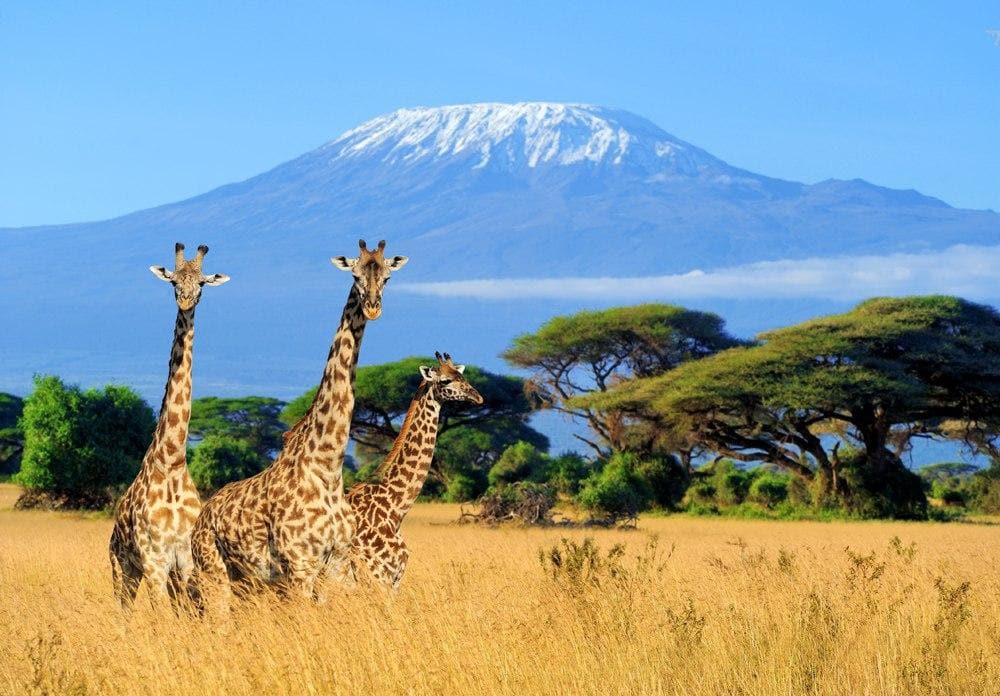Tanzania is the second largest country in East Africa and one of the continent’s major safari destinations. It lies on the idyllic Indian Ocean and shares borders with other incredible safari destinations.
Accessibility makes it easy to combine your visit to Tanzania with other safari destinations in East Africa like Kenya, Uganda, or Rwanda for a once-in-a-lifetime gorilla trekking adventure. Few destinations in Africa can rival Tanzania’s diversity of wildlife and landscapes. From the classic savannah destinations of the Serengeti, Tarangire National Park, and Ngorongoro Crater to the beaches and coral reefs of Zanzibar, a visit to Tanzania delivers one thrilling experience after another.
Tanzania offers excellent year-round game viewing. Because of the historically low density of human settlements, mainland Tanzania is home to an exceptionally rich array of wildlife. Large herds of wildebeests, zebras, giraffes, buffalo, gazelles, elands, dik-diks, and kudu are found in most of the country’s numerous game parks. Predators include hyenas, wild dogs, lions, leopards, and cheetahs. Crocodiles and hippopotamuses are common on riverbanks and lakeshores.
The government has taken extraordinary measures to protect rhinoceroses and elephants, which have fallen victim to poachers. Small bands of chimpanzees inhabit Gombe National Park along Lake Tanganyika. Nearly 1,500 varieties of birds inhabit the area, and there are numerous species of snakes and lizards. In all, about one-fourth of Tanzania’s land has been set aside to form an extensive network of reserves, conservation areas, and national parks, a number of which have been designated UNESCO World Heritage sites.

Without a doubt, Tanzania’s greatest wildlife attraction is the annual Wildebeest Migration, which sees almost two million wildebeest and zebra follow seasonal rains across the Serengeti-Mara Ecosystem each year.
The greatest wildlife attraction is the Great Wildebeest Migration through Tanzania and Kenya each year. It is the largest overland wildlife migration in the world. Almost two million wildebeest, zebra, and gazelle move in an 800 km circuit clockwise through the Serengeti and Masai Mara ecosystem in search of pastures and water. They are followed by lions and other predators in their thousands and are waited for patiently by crocodiles in the rivers.

A trip to Tanzania would not be complete without a visit to Mt Kilimanjaro, Africa’s highest mountain and one of the world’s highest volcanoes. A snow-capped mountain on the equator is one of the continent’s most magnificent sights. At 5,896m it is a serious climb to the summit! Tanzania offers superb safari-and-beach combinations, thanks to its long tropical coastline and coral-fringed islands. You can easily fly from a safari camp after breakfast and be on a white sandy beach in time for sunset cocktails.
Tanzania’s top tropical islands are:
Zanzibar – one of the world’s most romantic honeymoon destinations
Mnemba Island – a private island holiday paradise
Pemba Island – is among the world’s best diving sites
Mafia Island – swim with migrating whale sharks (October to April).
When is the best time to go to Tanzania?
Deciding when to visit Tanzania depends entirely on what it is that you want to experience. Peak game viewing in Tanzania is in the dry winter season (June to October). This is the ideal time to explore the Serengeti, Ngorogoro Crater, and Lake Manyara because the game park is concentrated around water sources. The Great Migration river crossings also take place between July and October.
If you prefer to avoid high-season crowds, we recommend combining Ruaha and Selous with a beach break on the coast or heading to Lake Victoria to combine chimp trekking in Mahale and Gombe with game viewing in the Katavi.
During the low or Green Season (November to March), there are baby animals everywhere, the days are deliciously hot, the dust is settled by afternoon thunderstorms and, best of all, you will enjoy value for money and crowd-free game viewing. Game viewing is still excellent after the short rains in November but, for the best value, travel before 15 December to avoid the Christmas crowds (and prices!).
For keen photographers, this quiet period offers incredibly special advantages: expect lush green landscapes rather than the dull browns of winter; dramatic cloudy skies rather than winter’s endless pale blue skies; and much more relaxed game viewing conditions, which means more time to get that winning shot.
The best time to climb to the summit of Mt Kilimanjaro is between July and October or between January and March. This makes it easy to combine a mountain trek with both game viewing and relaxing on a tropical island. Combine your big game safari with Tanzania’s islands between August and October. We do not recommend the coast or islands during the long rains from March to May when it is very wet and
humid.


